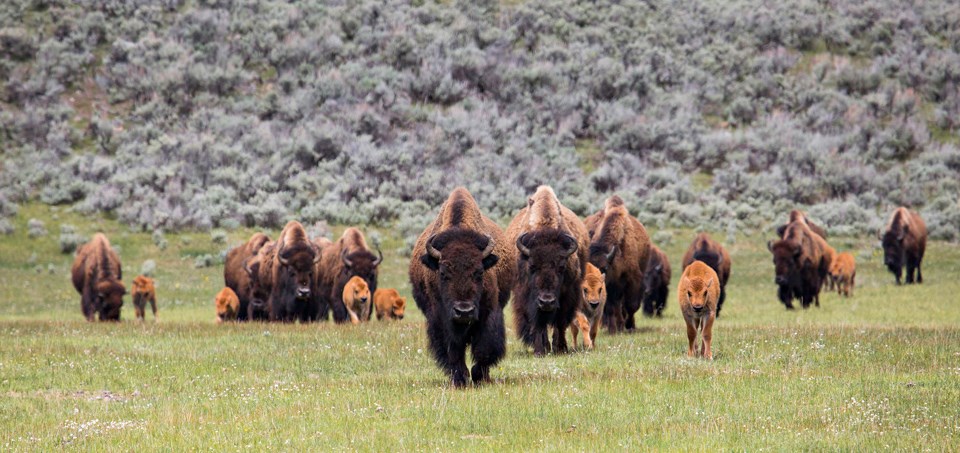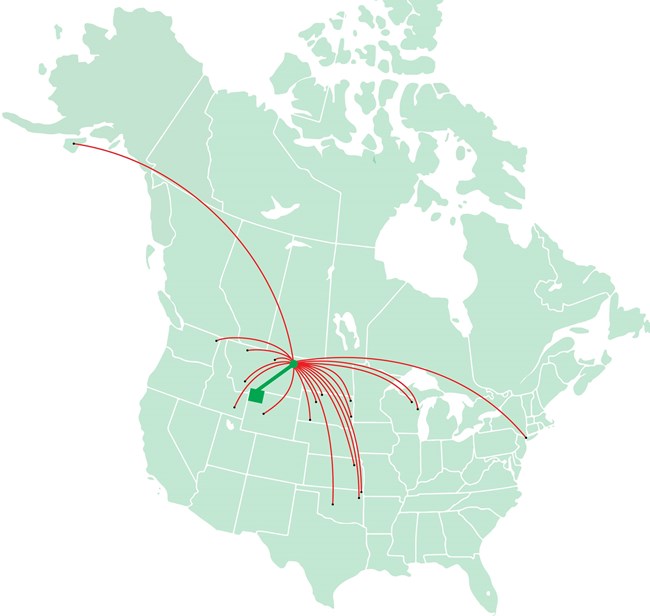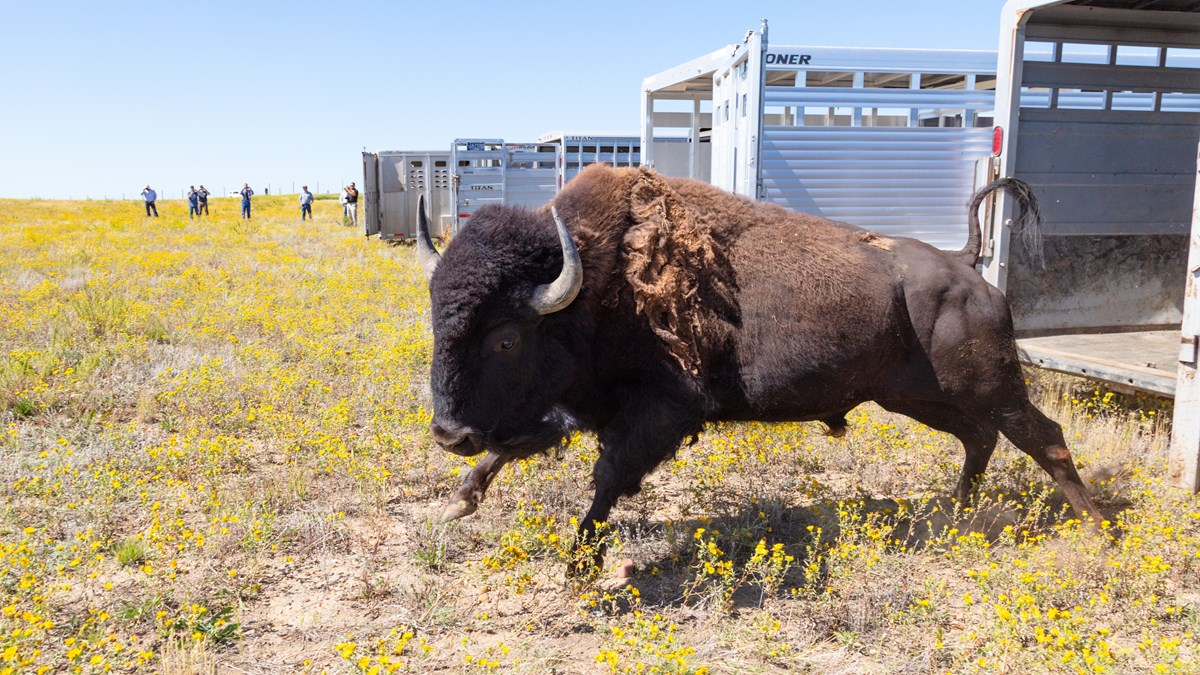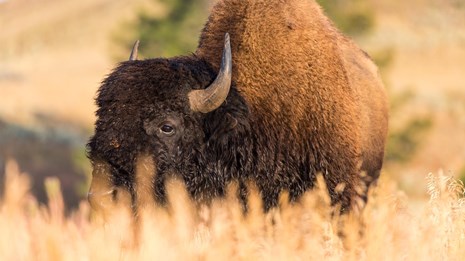Yellowstone Planning to Kill Bison to Make the Beef People Happy
Visit our keyboard shortcuts docs for details
- Duration:
- 2 minutes, five seconds
The protection and recovery of bison in Yellowstone is 1 of the great triumphs of American conservation. This video explains why bison numbers are controlled in Yellowstone.
On This Folio Navigation
Success & Controversy
The protection and recovery of bison in Yellowstone is one of the smashing triumphs of American conservation. In 1902, afterwards years of market place hunting and poaching, at that place were only about 2 dozen bison left in Yellowstone. Over the adjacent 100+ years, park employees worked to bring this species back from the brink of extinction. We succeeded, and at present face the challenge of helping to manage a healthy population of bison that sometimes roams beyond park borders onto individual land and land managed by other agencies, where there is less tolerance for them.
A courtroom-mediated settlement reached in 2000 created the Interagency Bison Management Program (IBMP), which established a cooperative effort to manage bison in and around Yellowstone. 8 groups, including state and federal agencies and Tribal Nations, play a office in making decisions nigh Yellowstone bison. Because Montana police force limits the areas bison can motion exterior the park, and because bison outside the park are valued by state and Tribal hunters and others, managing bison is a balancing act between having enough bison to support a healthy population and some migrations out of the park, merely not besides big a population that could atomic number 82 to mass migrations and crusade brucellosis transmission to livestock, harm people, or impairment private property. Currently, the park'southward bison population is managed through iii main means: (1) Tribal hunts and state hunts exterior Yellowstone'south boundary; (2) capture and transfer to Tribes for shipment to slaughter; and (3) capture for brucellosis testing and transfer to Tribes to beginning their own bison herds.
Beginning in 2018, the park, in coordination with several federal and country partners and Tribal Nations, started the Bison Conservation Transfer Program to place migrating bison that practice not have brucellosis and transfer them to new areas equally an alternative to sending them to slaughter. Since 2019, 182 bison have been transferred to the Assiniboine and Sioux Tribes of the Fort Peck Indian Reservation. Of those, roughly 140 were transferred to the InterTribal Buffalo Council and given to about twenty other member Tribes beyond Due north America, which has been the largest transfer of Yellowstone bison among Native American Tribes in history.

NPS / Neal Herbert
Our Goals
We work to maintain a feasible, wild, migratory population of our national mammal.
Yellowstone provides one of the few places where bison live much similar their ancestors did: unfenced, and unprotected from harsh winters, drought, or predation. Yellowstone bison also provide a concrete link to those ancestors. They were declared our national mammal in 2016 because they're a symbol of wild America, an important office of our heritage, and a key player in an ecosystem that's much larger than a national park.
We want to transport Yellowstone bison to other conservation areas instead of slaughter.
Yellowstone National Park built a partnership with Yellowstone Forever and the Greater Yellowstone Coalition to more than double program capacity and lower the number of animals sent to slaughter. These improvements will increase capacity from property 80 to 200 animals. Using the new facility in coordination with APHIS and their leased facility exterior the park volition upshot in transferring about 100 animals per year to Tribes as an alternative to slaughter.
We want to support hunting opportunities outside the park.
Correct now, most hunting occurs adjacent to the park boundary, which prohibits bison from moving further into areas where they are tolerated. Yellowstone National Park wants to work with state partners and Tribal Nations to explore ways to safely improve hunting outside the park. Improving hunts would further reduce the numbers of animals sent to slaughter and help care for bison like other wild fauna, such as elk.
The NPS is initiating a new Ecology Affect Argument (EIS) procedure to set a Bison Management Plan to address NPS direction actions within the park boundary that will incorporate new information and changed circumstances since the 2000 program was approved. A new programme is needed because of new information and changed circumstances since the 2000 IBMP was canonical. The following cooperating agencies volition provide input during the National Environmental Policy Act (NEPA) procedure: Confederated Salish and Kootenai Tribes, InterTribal Buffalo Quango (ITBC), Nez Perce Tribe, State of Montana- Department of Fish, Wildlife and Parks and Department of Livestock, United states of america Department of Agriculture (USDA) Animal and Found Health Inspection Service (APHIS) and Forest Service - Custer Gallatin National Wood. For boosted information on the EIS process, the public meetings, and how to provide comments, please visit: https://parkplanning.nps.gov/YellowstoneBisonEIS.
Bison Conservation Transfer Program
Relocating Bison
During August 19-23, 2019, Yellowstone moved 55 bison to the Fort Peck Indian Reservation in northeastern Montana. Information technology was the starting time direct relocation of bison to a new dwelling as an alternative to slaughter and was the culmination of viii years of compromise between the federal authorities, state of Montana, and Fort Peck Assiniboine and Sioux Tribes. Those bison had been held in a quarantine facility in the park for 17 months and underwent rigorous testing to prove they did non take a illness chosen brucellosis.
Upward until 2020, rehoming bison has not been possible because of brucellosis. Some Yellowstone bison are infected with this disease, which affects bison, elk, and domestic cows past reducing production in livestock and marginally affecting bison health. To assistance stop the spread, Montana law prohibits the live transfer of Yellowstone bison to new areas unless they are first certified as brucellosis-free. Brucellosis-causing leaner evade the immune system in early stages, such that an infected bison may not test positive for the starting time several months or longer afterward contracting the disease. Proving a bison does non take brucellosis takes much more than testing them i time when animals are rounded up. It takes placing them in fenced quarantine pastures with similarly aged animals and repeatedly testing them for one to three years. From 2005-2012, Animal and Constitute Health Inspection Service (APHIS) developed and verified procedures for identifying Yellowstone bison that don't have brucellosis. Later on, the park, Fort Peck Assiniboine and Sioux Tribes, state of Montana, and APHIS agreed on how to implement the procedures.

Every bit bison migrate north out of the park, some are captured and entered in the Bison Conservation Transfer Programme. Animals are then moved between facilities to undergo various testing phases. The first two testing phases are completed in Yellowstone quarantine facilities (Stephens Creek) or on private lands leased by APHIS near the northern park purlieus. APHIS and Montana animal wellness officials certify bison as brucellosis-free at the completion of Phase 2, allowing their transfer beyond Montana to the Fort Peck Reservation, where bison complete Phase three. Subsequently, the Fort Peck Tribes transfer some bison to the InterTribal Buffalo Quango, who distribute them to other Tribes beyond North America.
The Fort Peck Assiniboine and Sioux Tribes started their Yellowstone herd past accepting bison that completed the 2005-2012 pilot written report. In 2012, 63 animals were transferred, and 138 were transferred in 2014. Yellowstone and APHIS transferred 93 bison to the Fort Peck Tribes in 2019, 11 in 2020, fifty in 2021, and 28 so far in 2022. Currently, these Tribes conserve 300-400 bison beyond 18,000+ acres on their lands.
The Bison Conservation Transfer program has led to the largest transfer of Yellowstone bison among Native American Tribes in history.
Expanding the Bison Conservation Transfer Program
Currently, there is non plenty space for all the bison that qualify for the plan. The outset two phases of testing require that animals are held within country- and federal-approved quarantine facilities. There are currently two such facilities, i within Yellowstone National Park and the other on private land leased by APHIS well-nigh the northern park boundary. Yellowstone partnered with Yellowstone Forever and Greater Yellowstone Coalition to increase the capacity of the facility inside the park from holding 80 animals to 200 animals. Improvements are existence completed in 2021/2022. These improvements and continued coordination with APHIS volition result in transferring about 100 animals per twelvemonth to Tribes as an alternative to slaughter.
Conserving large herds is i of the greatest wildlife restoration challenges of our generation. Yellowstone bison remain the model of restoring large, wild herds. There is not another bison population who, by their sheer numbers, restore lost ecosystem processes across large landscapes. The large herds provide unparalleled reconnections of people to the long-lost herds that in one case roamed the continent, but the benefits of large numbers come with the challenge of managing big numbers. The Bison Conservation Transfer Program cannot solve the dilemma of needing to remove large numbers of bison from the population each twelvemonth, but it may brand conserving big herds more doable.
Yellowstone bison take some of the nearly valuable genetics for long-term conservation of the species and can only exist augmented into other herds through the Bison Conservation Transfer Program. Bison completing the program are transferred to Native American Tribes to help restore their lost cultures and ways of life. Yellowstone bison may mean more to them than most other people. Entire cultures are intertwined with bison and the neat herds that one time roamed North America.
"I longed for that fourth dimension when Tatanka Sicun, Buffalo Spirit every bit ancestor, mingled with mine...
... then yesterday it came...
... information technology came in the class of trucks and trailers conveying sacred beings into the realm of our college plains..."
-Lois Ruddy Elk, member of Fort Peck Sioux, about the 2019 bison transfer

NPS / Jacob W. Frank
Many Tribes see Yellowstone bison as uniquely linked to their ancestral descendants because they were never completely extirpated from the park. To many Tribal members, returning bison to Tribal lands goes well across finding an alternative to slaughter. It is about restoring a part of themselves that is missing.
Negotiating more tolerance for bison outside Yellowstone is going to accept a long time. In fact, we may never find enough tolerance outside the park to eliminate the demand for some population control. In the interim, identifying brucellosis-free bison and moving them to new homes may be part of the solution to giving bison more room to roam. It is the beginning of returning Yellowstone bison to the lands where they once roamed.
What You Tin can Practise
Questions & Answers
Direction
-
Bison are killed because they practice not accept enough room to roam. Yellowstone encompasses a limited amount of habitat. Montana allows very limited numbers of bison in pocket-sized areas side by side to the park due to fears they might transmit brucellosis to cattle and out of concerns almost competition with cattle for grass, human being rubber, and property impairment.
-
Bison are infected with the illness brucellosis which prohibits transferring them live to new places, unless they are kickoff certified disease-complimentary. Certification involves a multi-year process including holding animals in fenced pastures near the park boundary and only nigh 30% of animals qualify for the program.
-
Yellowstone bison reproduce and survive at relatively high rates compared to many other large, wild, mammal species. The bison population currently increases by ten% to 17% per year.
-
Currently, predation past bears and wolves has footling effect in reducing the bison numbers. Bison are massive animals that defend themselves as a group, making them more difficult to attack than animals such as elk.
-
By itself, hunting exterior the park has not been effective at limiting bison numbers considering full-bodied hunting pressure forth the park purlieus often causes bison to return to the security of the national park where hunting is prohibited.
A full of 187 bison were removed during the 2020/2021 winter, which was below the range of 500 to 700 agreed to by managers. Removals included 187 bison harvested outside the park in Montana; nil bison captured at the Stephens Creek facility; and cypher entered in brucellosis-quarantine.
For the 2021/2022 winter, the NPS recommended removing 600 to 900 bison to slightly reduce the population to 4,300-iv,700 at the end of wintertime and 5,200-5,700 animals after calving. Removals should only occur near the northern park boundary where animals from the central and northern herds intermix. Managers should track migrations and focus removals on the northern herd. If initial removal targets are met and numbers of bison exiting the park exceed tolerance for them, upwards to 200 additional animals could be harvested or captured in tardily winter.
Yes. Yellowstone'southward bison population has grown steadily over the concluding 50 years: from 500 animals in 1970 to more than 5,000 today. Yellowstone bison correspond a unique source of genetic diversity.
Bison migrate to lower elevations where food is more available (less snow) just like bighorn sheep, elk, mule deer, pronghorn, and many other animals. They render to the park's higher elevation grasslands to feed during summer.
Bison are not allowed to move freely outside Yellowstone due to fears they might transmit brucellosis to cattle, and out of concerns about competition with cattle for grass, man safety, and property damage. Elk are besides infected with brucellosis, but their movements outside the park are not restricted. State governments command the management of wild fauna outside Yellowstone (unless a species is federally listed as threatened or endangered).
Outside Yellowstone, states manage wildlife and Yellowstone cannot forcefulness them to tolerate more migrating bison.
Yellowstone isn't big enough to manage a migratory species like bison on its ain. Bison conservation is a shared responsibility that crosses many political boundaries. Withdrawing from the IBMP would make it more hard to collaborate with the land management agencies and Tribes that share an interest in what happens to bison when they get out the park. Additionally, Yellowstone's superintendent is not the signatory of the original IBMP. The agreement was signed and approved by the Secretarial assistant of the Interior, who would need to make any decision about withdrawing.
On behalf of the IBMP, bison are captured about the due north boundary of Yellowstone equally they drift out of the park. Fences guide them into enclosures, so they wander in on their own or are sometimes guided in by riders on horseback. For more information on the capture and shipment process, browse photos on ourFlickr.
We transfer captured bison to Tribes who ship them to slaughterhouses for processing.
Tribal Nations distribute the bison meat and hides to their members.
No: we receive no payment for bison shipped from our capture facility.
No. The rubber of people and animals is our top priority at Stephens Creek. The Humane Club has evaluated the operation twice, and each time we've adopted their recommendations. During 2020, we received skilful preparation and worked to improve low-stress treatment of bison during treatment and processing. Two old photos are often used to falsely depict our handling practices at Stephens Creek. One shows a bison existence held with a olfactory organ ring during brucellosis testing, a practice nosotros haven't used in many years (nosotros now accept a hydraulic chute that holds the animals relatively still during testing). The second shows a bison existence carried by a front-end loader: a photo that was taken outside the park, about likely after a bison was shot by a hunter or hit by a car. Adult bison tin be very big and heavy and often times require heavy equipment to move carcasses from vehicle blow scenes. For a detailed view of the capture and shipment procedure, browse photos on ourFlickr.
No. Yellowstone'south bison population has grown steadily over the last 45 years: from 500 animals in 1970 to more than 5,000 in 2021. Each year, the bison population in the park increases past 10%-17%. Forth with elk, bison are the nigh numerous large mammals in Yellowstone, and periodic culling will not alter that fact. The sizes of most wild ungulate populations in North America are limited by hunting and/or captures and removals.
We are legally obligated to follow the directives of the IBMP. Each fellow member of the IBMP has a unlike perspective on the conservation of wild bison, and then conflict resolution is an integral role of the management strategy. We would similar to reduce the shipment of bison to slaughter and have implemented the Bison Conservation Transfer Program to reduce numbers slaughtered.
Brucellosis
- Brucellosis is a bacterial affliction that can induce abortions or stillbirths in infected animals but does not impale them. For ranchers, brucellosis has an economic impact because it affects the reproductive charge per unit and marketability of their animals.
- Up to 60% of Yellowstone bison examination positive for exposure to brucellosis (depending on historic period and sex activity).
- Brucellosis has been eradicated in cattle herds beyond most of the United States. Bison and elk in the Greater Yellowstone Ecosystem persist as one of the last reservoirs of infection.
- Brucellosis was introduced to Yellowstone bison and elk by domestic cattle in the early 1900s.
Aye. People both understate and overstate the risk of brucellosis manual. Transmission of brucellosis from bison to livestock is possible because in belatedly winter, bison migrate to depression elevation areas outside the park where livestock are concentrated. At this time, bison are late in their pregnancy: the virtually probable time for infected animals to abort fetuses that might be found past other animals. The fact that there's never been a documented transmission of brucellosis from Yellowstone bison to cattle does not mean it couldn't happen. Rather, it's a testament to the diligent direction efforts put forth by the land of Montana and the National Park Service to prevent commingling of bison and cattle during the time menses when manual is most likely.
Yes. Over the last two decades, more than than 20 livestock operators in the three states surrounding Yellowstone discovered brucellosis in their animals. In each case, wild elk transmitted the disease.
They exercise, but there is no vaccine that is 100% effective at reducing abortions due to brucellosis or eliminating the potential of infection from wildlife.
The NPS initiated the Bison Conservation Transfer Program to identify bison that don't have brucellosis and transfer them to new areas as an alternative to sending them to slaughter. Since 2019, 182 bison have been transferred to the Assiniboine and Sioux Tribes of the Fort Peck Indian Reservation. Of those, roughly 140 were transferred to the InterTribal Buffalo Council and given to near xx other fellow member Tribes across North America. Another 50 animals are planned to be moved to other Tribes during the 2021/2022 wintertime. Currently, 95 animals are in the program with 28 planned for transfer to the Fort Peck Assiniboine and Sioux Tribes during the 2021/2022 winter. The NPS and APHIS intend to enter 80-120 new animals into the program the 2021/2022 winter. Yellowstone is building a partnership with Yellowstone Forever and the Greater Yellowstone Coalition to more than double program capacity and lower the number of transfer-eligible animals sent to slaughter.
- Vaccinating wild bison against brucellosis with existing vaccines would not substantially suppress the affliction and could have unintended, adverse effects on the bison population in Yellowstone.
- At that place is no easily distributed, highly effective vaccine: electric current vaccines would only create a 10% to 15% reduction in infection, and immune protection is short-lived.
- Even if we reduced the prevalence of brucellosis in bison, they could be re-infected by elk.
- For more details, read the lastEcology Impact Argument that evaluated the potential of remote vaccination of bison.
Alternatives
In the history of North America, only humans, disease, predation, and starvation accept successfully controlled bison numbers. Hunting exterior the park is the preferred method for controlling the population today, but bison demand greater access to state to disperse beyond our boundaries and pioneer new areas. Currently, the area where bison can be hunted is very modest, and bison often respond to the hunting pressure level by returning to the security of the national park (where hunting is prohibited). In addition, the NPS initiated the Bison Conservation Transfer Program to identify bison that don't have brucellosis and transfer them to new areas every bit an alternative to sending them to slaughter. Since 2019, 182 bison accept been transferred to the Assiniboine and Sioux Tribes of the Fort Peck Indian Reservation. Of those, roughly 140 were transferred to the InterTribal Buffalo Council and given to near 20 other member Tribes across North America. Another 50 animals are planned to be moved to other Tribes during the 2021/2022 winter. Currently, 95 animals are in the program with 28 planned for transfer to the Fort Peck Assiniboine and Sioux Tribes during the 2021/2022 wintertime. The NPS and APHIS intend to enter fourscore-120 new animals into the program during the 2021/2022 winter. Yellowstone is building a partnership with Yellowstone Forever and the Greater Yellowstone Coalition to more than than double program capacity and lower the number of transfer-eligible animals sent to slaughter.
Right at present, information technology'due south against state and federal laws to move wild bison exposed to brucellosis anywhere except to meat processing and research facilities. The NPS has initiated the Bison Conservation Transfer Program to identify bison that practice not take brucellosis and transfer them to new areas equally an alternative to sending them to slaughter.
Some captured bison that test negative for brucellosis exposure are moved into double-fenced pastures and held until they all exam negative for two to three consecutive months. Whatsoever animals that convert to testing positive are removed and shipped to slaughter. The remainder of the bison and then undergo additional testing for brucellosis with timelines and criteria that vary by age and sex. At the end of this testing protocol, APHIS and state of Montana creature health officials certify the bison every bit brucellosis-costless. This certification allows their transfer across the country of Montana to the Fort Peck Indian Reservation. Bison complete one year of assurance testing at the Fort Peck Indian Reservation, after which the Fort Peck Assiniboine and Sioux Tribes transfer some bison to the InterTribal Buffalo Council who distribute them to member Tribes throughout Due north America.
This program reduces the need for capture/slaughter operations and promotes the restoration of plains bison to suitable areas of the country.
To engagement, hunting exterior the park has been ineffective at limiting bison numbers. The area where bison tin can exist hunted is very pocket-sized, and bison often reply to concentrated hunting pressure along the park boundary by returning the security of the national park where hunting is prohibited. For hunting to become more than effective, bison need greater access to public lands exterior the park, similar wild elk and other animals, so they tin disperse beyond our boundaries and pioneer new areas.
Federal law (National Park Protection Act, 1894) prohibits hunting in Yellowstone. Considering of this prohibition, Yellowstone offers some of the best wildlife viewing opportunities in the world. This prohibition too supports our goal to manage the park so that human activities have as footling effect on natural processes as possible. Allowing hunting in Yellowstone would drastically affect the behavior of animals and change the feel for people who come to watch them.
No fertility command methods that are affordable, easily delivered, highly effective, and reversible are currently bachelor for commitment to wild bison spread across a vast mural. Fertility control could have unintended, adverse effects on the bison population in Yellowstone.
More than Data

Bison Environmental
Acquire more about North America'southward largest country-dwelling mammal.
gutierrezpokenderyind.blogspot.com
Source: https://www.nps.gov/yell/learn/management/bison-management.htm
0 Response to "Yellowstone Planning to Kill Bison to Make the Beef People Happy"
Post a Comment